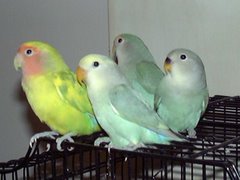How to Hand Feed the Baby Lovebirds?
When the mum and dad of your baby lovebirds are taking utmost care of their babies, you don't have to hand feed them.
Most of the owners preferred to go for hand feeding mainly due to disowning of their parents of varied reasons. In addition to this, hand feeding the baby lovebirds favor higher price, as it will be very tame and more sellable.
As hand-feeding process is time consuming, the persons who can get up early, stay up late and provide them with the feed several times during daytime only can begin this process of baby lovebirds rising.
Hand fed your babies when they attain two weeks old. This will provide them time for father and mother to start off pretty well.
Hand feeding formula includes wheatena, sunflower seed, and various kinds of baby food. Mix these ingredients and freeze it in ice cube trays. You can provide a fresh cube for each meal.
Although formula is pretty smelling and gross looking, the lovebird young ones just love it like anything. You can use a syringe with the nozzle sliced at a slant to take more feed through at a time. You mix the frozen feed with warm water, to a texture that is easily squeezed through the syringe and easily swallowed by the little ones Do sterilize the syringe after each use.
One of my client used pronutro, which is an excellent commercial food for rising lovebird chicks. Mix the Pronutro with warm water with a consistency of free flow through syringe.
Hold the baby lovebird in your hand; place the syringe into his beak, not too deep. Provide him one mouthful at a time, permitting him to swallow and breathe in-between. You ought to do this process at least once in 3 ½ to 4 hours. You should start at 7:00 am to 11:00 pm.
Most of the owners preferred to go for hand feeding mainly due to disowning of their parents of varied reasons. In addition to this, hand feeding the baby lovebirds favor higher price, as it will be very tame and more sellable.
As hand-feeding process is time consuming, the persons who can get up early, stay up late and provide them with the feed several times during daytime only can begin this process of baby lovebirds rising.
Hand fed your babies when they attain two weeks old. This will provide them time for father and mother to start off pretty well.
Hand feeding formula includes wheatena, sunflower seed, and various kinds of baby food. Mix these ingredients and freeze it in ice cube trays. You can provide a fresh cube for each meal.
Although formula is pretty smelling and gross looking, the lovebird young ones just love it like anything. You can use a syringe with the nozzle sliced at a slant to take more feed through at a time. You mix the frozen feed with warm water, to a texture that is easily squeezed through the syringe and easily swallowed by the little ones Do sterilize the syringe after each use.
One of my client used pronutro, which is an excellent commercial food for rising lovebird chicks. Mix the Pronutro with warm water with a consistency of free flow through syringe.
Hold the baby lovebird in your hand; place the syringe into his beak, not too deep. Provide him one mouthful at a time, permitting him to swallow and breathe in-between. You ought to do this process at least once in 3 ½ to 4 hours. You should start at 7:00 am to 11:00 pm.







 Free Ads For Bloggers
Free Ads For Bloggers

